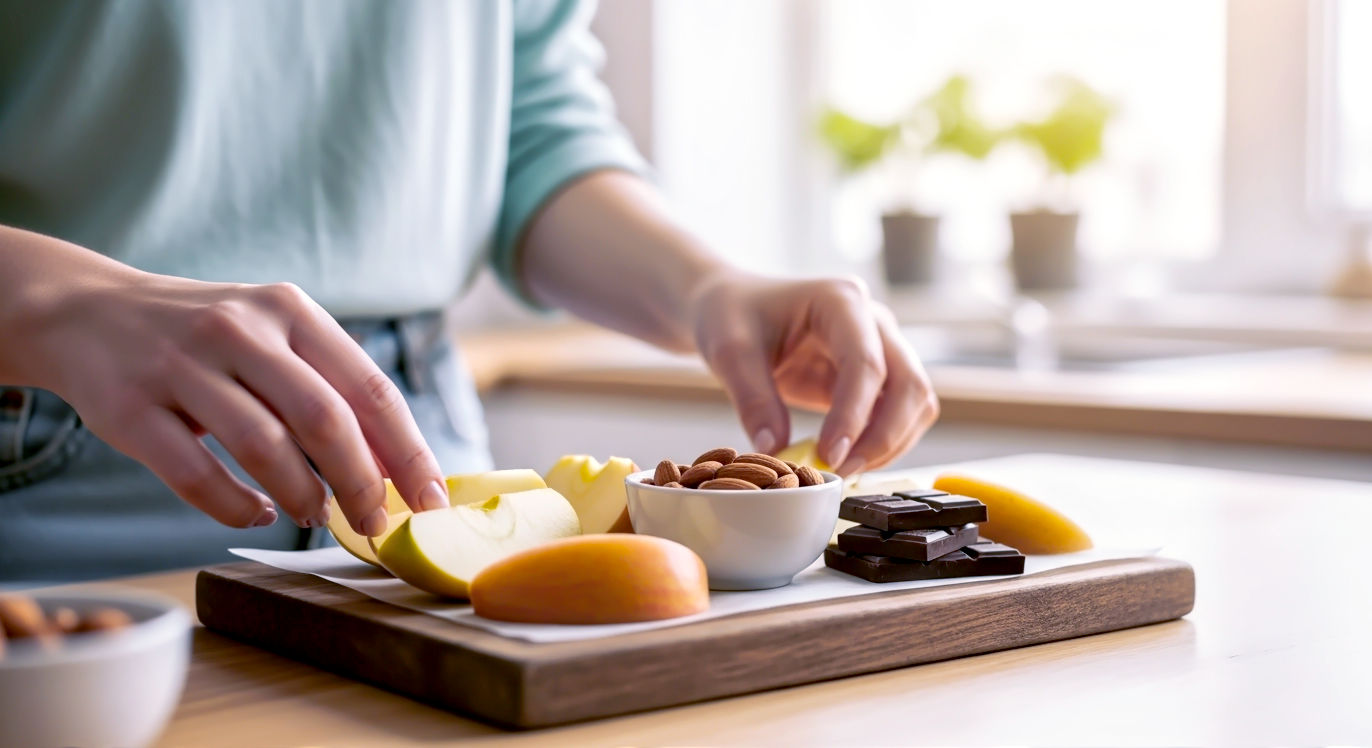The Guide to Conquering Sugar Cravings: Your Ultimate UK Handbook
Your ultimate guide to beating sugar cravings for good. Learn why you crave it, find practical tips, healthy swaps, and a step-by-step plan for a UK audience.

This post may contain affiliate links. If you make a purchase through these links, we may earn a commission at no additional cost to you.
Let’s be honest, we’ve all been there. It’s 3 p.m., the afternoon slump hits, and suddenly your brain is screaming for a biscuit. Or maybe it’s after dinner, when a little something sweet feels like the perfect end to the day. Before you know it, you’ve polished off half a packet of chocolate digestives or a family-sized bar of Dairy Milk. You’re not alone. In the UK, we’re famous for our love of tea and cake, puddings, and sweets. But sometimes, that sweet tooth can feel less like a gentle nudge and more like a nagging monster that won’t be silenced.
Sugar cravings are incredibly common, but they can also be incredibly frustrating. They can derail your healthy eating plans, drain your energy, and even affect your mood. The good news is, you’re not powerless. Understanding why you crave sugar is the first step to taking back control. It’s not just about willpower; it’s about biology, psychology, and the habits we’ve built up over a lifetime.
This guide is your roadmap to freedom from sugar cravings. We’ll dive into the science behind why that doughnut seems to call your name, explore the surprising triggers hiding in your daily routine, and give you practical, no-nonsense strategies that work in the real world. Whether you’re trying to cut down for your health, lose a bit of weight, or simply feel more in control of your eating habits, we’ve got you covered. Think of this as your complete toolkit for kicking the sugar habit for good, without feeling deprived or miserable.
Why Do We Crave Sugar? Unpacking the Science Behind the Sweet Tooth
Ever wondered why it’s so hard to say no to a sweet treat? It’s not a lack of willpower; it’s down to some pretty powerful stuff happening in your brain and body. When you eat sugar, it sets off a chain reaction that makes you feel good—for a little while, at least.
The Brain’s Reward System: A Quick Hit of Happiness
Your brain is wired to seek out things that help you survive, and in our evolutionary past, energy-dense foods like sugar were a rare and valuable find. When you eat something sugary, your brain releases a chemical called dopamine. This is the same “feel-good” chemical that’s released when you laugh with friends or get a promotion at work. It’s part of your brain’s reward system.
Think of it like this: your brain gives you a little burst of pleasure as a reward for finding a great source of energy. It essentially says, “Yes, that was good! Remember it and do it again.” This is why that first bite of a sticky toffee pudding feels so blissful. The problem is, modern life gives us access to sugar 24/7, unlike our ancestors who might have only found honey or ripe fruit occasionally. This constant access can hijack our reward system, making us crave that dopamine hit again and again.
The Blood Sugar Rollercoaster: Up, Down, and Craving Again
When you eat sugary foods, especially those without much fibre or protein (like sweets, fizzy drinks, or white bread), the sugar is absorbed into your bloodstream very quickly. This causes a rapid spike in your blood sugar levels. Your body doesn’t like this sudden spike, so it releases a hormone called insulin to move the sugar out of your blood and into your cells for energy.
The trouble is, your body sometimes overreacts. It can release a bit too much insulin, which causes your blood sugar to crash and fall below normal levels. This is often called a “sugar crash.” When this happens, you might feel tired, irritable, shaky, and foggy-headed. Your body’s immediate reaction? It sends out an urgent signal for more quick energy, and your brain knows exactly what will do the trick: more sugar. This creates a vicious cycle:
- You eat sugar.
- Blood sugar spikes.
- Insulin rushes in.
- Blood sugar crashes.
- You crave more sugar.
This rollercoaster is one of the biggest drivers of persistent sugar cravings. You’re not just chasing a taste; your body is trying to rebalance its energy levels.
The Gut Connection: Your Second Brain Has a Say
Your gut is home to trillions of bacteria, and they have a surprising amount of influence over your health and even your cravings. Some types of gut bacteria thrive on sugar. When you eat a lot of sugary foods, you’re essentially feeding these sugar-loving microbes, helping them multiply.
These little critters can actually send signals to your brain, influencing your food choices and making you crave the very foods they need to survive. So, if you feel like you have an insatiable sweet tooth, it might be your gut bacteria pulling the strings. The good news is that you can change your gut microbiome. By eating less sugar and more fibre-rich foods, you can encourage the growth of beneficial bacteria that don’t constantly demand a sugary feast.
Habit and Emotional Triggers: It’s Not Just Physical
Cravings aren’t just about biology; they’re deeply tied to our habits and emotions.
- Habitual Cravings: Do you always have a biscuit with your cup of tea? Or grab a chocolate bar on your way home from work? These are learned habits. Your brain has created a strong association between a certain time, place, or activity and a sugary treat. The craving is triggered by the cue, not necessarily by hunger.
- Emotional Eating: Many of us turn to sugar when we’re feeling stressed, sad, bored, or even happy. Sugar provides a quick and easy comfort. It’s a temporary distraction from difficult feelings. If you often find yourself reaching for sweets when you’re not physically hungry, you might be an emotional eater. Recognising these emotional triggers is a massive step towards breaking the cycle.
Understanding these forces is key. Your sugar cravings aren’t a personal failing. They’re a complex mix of brain chemistry, hormonal responses, gut health, and learned behaviours. By understanding what’s driving them, you can start to address the root causes instead of just fighting a constant battle of willpower.
The Sneaky Places Sugar Hides: Are You Eating More Than You Think?
You might be diligently avoiding cakes and biscuits, but sugar is a master of disguise. It lurks in many everyday foods that are often marketed as healthy, making it easy to consume far more than you realise. The NHS recommends that adults have no more than 30g of free sugars a day, which is roughly seven sugar cubes. Let’s uncover some of the common culprits.
What Are “Free Sugars”?
First, it’s important to know what we’re talking about. Free sugars are any sugars added to food or drinks. This includes the sugar you stir into your tea, as well as sugars in honey, syrups (like maple and agave), and unsweetened fruit juices. The sugar naturally present in milk, fruit, and vegetables doesn’t count as free sugar. It’s the added stuff we need to watch.
The Usual Suspects: Obvious Sugar Traps
Let’s start with the easy ones. We all know these are high in sugar, but the amounts can still be shocking.
- Fizzy Drinks: A single 330ml can of cola can contain up to 35g of sugar—that’s your entire daily limit in one go.
- Sweets and Chocolate: A standard 45g bar of milk chocolate can have around 25g of sugar.
- Cakes and Biscuits: A slice of chocolate fudge cake can pack over 40g of sugar, and just two chocolate digestive biscuits contain nearly 10g.
The Hidden Sugar Culprits: Foods You Thought Were Healthy
This is where it gets tricky. Many savoury or “healthy” foods are loaded with hidden sugar to improve their taste and texture.
- Breakfast Cereals: Many popular cereals are packed with sugar. A small bowl of frosted flakes can contain over 10g. Even healthier-sounding options like granola can be very high in sugar, sometimes with 15g or more per serving. Check the label: Look for cereals with a green traffic light for sugar. Porridge oats are a great alternative.
- Yoghurts: Flavoured yoghurts, especially low-fat versions, are often loaded with sugar to make up for the lack of fat. A single pot of fruit yoghurt can contain 15-20g of sugar. Tip: Opt for plain natural or Greek yoghurt and add your own fresh fruit for sweetness.
- Sauces and Condiments: This is a big one. A tablespoon of ketchup contains around 4g of sugar (one teaspoon). Pasta sauces, stir-in sauces, and salad dressings are also major sources. A single serving of jarred pasta sauce can have 6-12g of sugar.
- “Healthy” Snacks: Cereal bars and protein bars can be deceptive. While they sound nutritious, many are held together with sugar syrups and can contain as much sugar as a chocolate bar.
- Bread: Even standard sliced bread, particularly wholemeal, can contain added sugar to aid the baking process and improve flavour. It’s usually a small amount per slice, but it adds up.
- Ready Meals: Convenience often comes at a sugary cost. Many ready meals, from curries to pasta dishes, have high levels of added sugar to enhance flavour. Always check the nutritional information.
- Fruit Juice and Smoothies: While they contain vitamins, fruit juices are a concentrated source of free sugar. A glass of orange juice has lost all the fibre from the fruit, so you’re just getting a sugar hit. The NHS advises limiting fruit juice and smoothies to just one 150ml glass per day.
How to Become a Sugar Detective: Reading Food Labels
Learning to read food labels is your secret weapon in the fight against hidden sugars. Here’s what to look for:
- Check the “Carbohydrates (of which sugars)” figure: This is the most important part. On the nutritional information panel, this tells you the total amount of sugar in the product per 100g and per serving.
- High: Over 22.5g of total sugars per 100g.
- Low: 5g of total sugars or less per 100g.
- Look at the ingredients list: Ingredients are listed in order of weight, so the higher up sugar is on the list, the more of it there is in the product.
- Know sugar’s many names: Manufacturers use over 50 different names for sugar. Be on the lookout for:
- Sucrose
- Glucose
- Fructose
- Maltose
- Corn syrup / High-fructose corn syrup
- Honey
- Agave nectar
- Molasses
- Hydrolysed starch
- Words ending in “-ose”
By becoming more aware of where sugar is hiding, you can make smarter choices and significantly reduce your intake without feeling like you’re on a restrictive diet. It’s about being informed, not about banning everything you enjoy.
Your 8-Step Battle Plan to Beat Sugar Cravings for Good
Ready to take control? This practical, step-by-step plan is designed to help you break the sugar cycle and build healthier habits that last. It’s not about going cold turkey overnight; it’s about making smart, sustainable changes.
Step 1: Balance Your Meals to Stabilise Blood Sugar
This is the foundation of conquering cravings. The goal is to get off the blood sugar rollercoaster. Every meal should be a balanced plate of:
- Protein: Chicken, fish, eggs, tofu, beans, lentils. Protein is digested slowly, which helps you feel full and satisfied for longer.
- Healthy Fats: Avocado, nuts, seeds, olive oil. Fats also slow down digestion and help stabilise blood sugar.
- High-Fibre Carbohydrates: Wholegrains (brown rice, quinoa, oats), vegetables, and legumes. Fibre slows the release of sugar into your bloodstream, preventing those sharp spikes and crashes.
Action Plan: At your next meal, look at your plate. Is there a good source of protein, a little healthy fat, and plenty of fibre? If not, what could you add? A handful of spinach in your eggs? Some avocado with your toast? A side of lentils with your soup?
Step 2: Don’t Skip Meals, Especially Breakfast
When you skip a meal, your blood sugar levels drop, leaving you ravenous and much more likely to reach for a quick, sugary fix. Starting your day with a balanced breakfast is crucial. It sets your blood sugar on a stable course for the rest of the day.
Action Plan: If you’re not a breakfast person, start small. A pot of plain Greek yoghurt with some berries and seeds, a couple of boiled eggs, or a slice of wholegrain toast with peanut butter are all great options that take minutes to prepare.
Step 3: Hydrate, Hydrate, Hydrate
Sometimes, your body mistakes thirst for hunger or a craving. Before you reach for a snack, drink a large glass of water and wait 10 minutes. You might find the craving disappears. Dehydration can also cause fatigue and brain fog, which are common triggers for reaching for sugar for a quick energy boost.
Action Plan: Carry a reusable water bottle with you throughout the day. If you find plain water boring, try adding a slice of lemon, lime, or some fresh mint. Herbal teas also count!
Step 4: Plan for Your “Craving Hotspots”
We all have them. That 3 p.m. slump at work, the evening sofa session, or the commute home. These are your “craving hotspots.” The key is to be prepared.
Action Plan: Identify your personal danger zones. Then, have a healthy, satisfying snack ready to go. Good options include:
- A small handful of almonds or walnuts.
- An apple with a spoonful of peanut butter.
- A small pot of plain yoghurt.
- A couple of oatcakes with hummus.
- A hard-boiled egg.
Having a healthy alternative on hand means you won’t be tempted by the office biscuit tin or the vending machine.
Step 5: Get a Good Night’s Sleep
Lack of sleep wreaks havoc on your hormones. It increases ghrelin (the “hunger hormone”) and decreases leptin (the “fullness hormone”). This hormonal imbalance makes you feel hungrier and more prone to cravings, especially for high-energy, sugary foods. Plus, when you’re tired, your willpower is at its lowest.
Action Plan: Aim for 7-9 hours of quality sleep per night. Create a relaxing bedtime routine: turn off screens an hour before bed, have a warm bath, read a book, or listen to calming music. Make your bedroom a sanctuary for sleep.
Step 6: Move Your Body
Exercise is a powerful tool for managing cravings. It can boost your mood by releasing endorphins (natural “feel-good” chemicals), which can reduce the need for a sugar-induced dopamine hit. It also helps to improve your body’s sensitivity to insulin, which leads to more stable blood sugar levels.
Action Plan: You don’t have to run a marathon. A brisk 15-20 minute walk during your lunch break can be enough to curb a craving. Find an activity you enjoy, whether it’s dancing in your kitchen, gardening, or cycling.
Step 7: Manage Your Stress Levels
Stress is a major trigger for sugar cravings. When you’re stressed, your body releases a hormone called cortisol. High cortisol levels can increase appetite and drive cravings for “comfort foods”—which are usually high in sugar and fat.
Action Plan: Find healthy ways to manage stress. This could be mindfulness or meditation (apps like Calm or Headspace are great), deep breathing exercises, yoga, spending time in nature, or talking to a friend. Even 5 minutes of mindful breathing can make a big difference.
Step 8: Reduce Sugar Gradually, Don’t Go Cold Turkey
For most people, trying to cut out all sugar at once is a recipe for disaster. It can lead to intense cravings, headaches, and irritability, making you more likely to give up and binge. A gradual approach is more sustainable.
Action Plan: Start by making small swaps.
- If you have two sugars in your tea, cut down to one for a week, then half, then none.
- Swap your sugary cereal for porridge with berries.
- Switch from fizzy drinks to sparkling water with a splash of fruit juice.
- Instead of a chocolate bar, try a few squares of dark chocolate (70% cocoa or higher).
These small changes add up over time and allow your taste buds to adjust. Soon, you’ll find that overly sweet foods taste less appealing.
Healthy Swaps and Sugar-Free Snack Ideas
One of the best ways to beat sugar cravings is to have delicious, healthy alternatives at the ready. This isn’t about deprivation; it’s about upgrading your choices. Here are some simple swaps and easy snack ideas to keep you satisfied.
Smart Swaps for Everyday Favourites
- Instead of sugary breakfast cereal…
- Try: Porridge oats made with milk or water, topped with berries, nuts, and a sprinkle of cinnamon. Cinnamon can help stabilise blood sugar and adds natural sweetness.
- Instead of flavoured yoghurt…
- Try: Plain Greek or natural yoghurt with your own additions: fresh fruit, a teaspoon of seeds (chia or flax), or a small drizzle of honey if you need a touch of sweetness (this still counts as free sugar, but you control the amount).
- Instead of a fizzy drink…
- Try: Sparkling water with a squeeze of fresh lemon or lime, or infused with mint and cucumber. Unsweetened herbal teas (like peppermint or berry) are also great hot or cold.
- Instead of jam on your toast…
- Try: Mashed banana or avocado, or a thin layer of sugar-free peanut or almond butter.
- Instead of a chocolate bar in the afternoon…
- Try: A small handful of almonds and two squares of dark chocolate (70% cocoa or more). The bitterness of the dark chocolate is often enough to satisfy a craving, and the nuts provide protein and healthy fats to keep you full.
- Instead of ketchup or sweet chilli sauce…
- Try: Making your own sauces or using herbs and spices for flavour. Salsa (check for no added sugar), mustard, or a dollop of pesto are often better choices.
Quick and Easy Craving-Busting Snacks
Keep these on hand for when a craving strikes. The key is a combination of protein, fat, and/or fibre.
- Apple Slices with Nut Butter: The classic combination of sweet, crunchy, and creamy. The apple’s fibre and the nut butter’s protein and fat make this a very satisfying snack.
- A Handful of Berries with Plain Yoghurt: Berries are lower in sugar than many other fruits and are packed with antioxidants. Paired with protein-rich yoghurt, it’s a perfect mini-meal.
- Hard-Boiled Eggs: A powerhouse of protein. They’re easy to prepare in advance and keep in the fridge for a quick, filling snack.
- Oatcakes with Hummus or Cottage Cheese: Oatcakes provide slow-release energy, while hummus or cottage cheese adds a savoury protein boost.
- A Small Handful of Nuts and Seeds: Almonds, walnuts, and pumpkin seeds are excellent choices. They are full of healthy fats, protein, and fibre. Be mindful of portion size—a small, closed handful is about right.
- Edamame Beans: You can buy them frozen and simply steam or microwave them. A sprinkle of sea salt makes them a delicious and protein-packed snack.
- Olives: A great savoury option when you’re craving something salty instead of sweet. They provide healthy fats that help with satiety.
- “Nice” Cream: For a dessert craving, blend one frozen banana with a splash of milk until it’s thick and creamy. It has the texture of ice cream without any added sugar. You can add a spoonful of cocoa powder for a chocolatey version.
By planning ahead and stocking your kitchen with these healthier alternatives, you empower yourself to make a better choice when a craving hits. You’re no longer at the mercy of the vending machine or the corner shop.
Mindful Eating: A Powerful Tool Against Cravings
So far, we’ve talked a lot about what to eat, but how you eat can be just as important. Mindful eating is the practice of paying full attention to your food—the taste, smell, texture, and how it makes your body feel. It’s the opposite of mindlessly munching in front of the TV. By becoming more mindful, you can get back in touch with your body’s true hunger and fullness signals, which is a game-changer for managing cravings.
What is Mindful Eating?
At its core, mindful eating involves:
- Eating slowly and without distraction. No phones, no TV, no working at your desk.
- Listening to your body’s hunger cues. Are you truly hungry, or just bored, stressed, or tired?
- Engaging all your senses. Notice the colours, smells, textures, and flavours of your food.
- Recognising when you’re full. Stop eating when you feel satisfied, not stuffed.
- Acknowledging your feelings about food. Understanding the connection between your emotions and your eating habits without judgment.
How Mindfulness Helps Tame the Sugar Monster
- It Creates a “Pause Button”: When a sugar craving hits, it can feel urgent and overwhelming. Mindfulness teaches you to pause before you react. In that pause, you can ask yourself a simple question: “What do I really need right now?” The answer might be a glass of water, a short walk, a few deep breaths, or a chat with a colleague. Often, the craving isn’t about the food itself.
- It Increases Satisfaction: When you eat mindfully, you savour every bite. This means you can get the same amount of pleasure and satisfaction from a smaller portion. You might find that two squares of dark chocolate, eaten slowly and with full attention, are far more satisfying than a whole bar wolfed down without thinking. This can be incredibly helpful for enjoying treats in moderation without feeling the need to overindulge.
- It Helps You Identify Triggers: By paying closer attention to when your cravings appear, you can start to see patterns. “Oh, I always want something sweet after that stressful team meeting.” Once you identify the trigger, you can find a non-food-based way to deal with it, like going for a quick walk or doing a 5-minute meditation.
- It Reduces Guilt and “All-or-Nothing” Thinking: Mindful eating is not about being perfect. It’s about awareness and non-judgment. If you do decide to eat the cake, you do it mindfully. You enjoy it, savour it, and then move on, without the guilt that so often leads to a cycle of “I’ve ruined my diet, so I might as well eat the whole cake.”
A Simple Mindful Eating Exercise: The Chocolate Meditation
This is a great way to practice. You’ll need one square of chocolate (dark is great for this).
- Observe: Before you even unwrap it, look at the packaging. Notice the colours and textures.
- Unwrap: Listen to the sound of the wrapper crinkling.
- See: Look at the square of chocolate. Notice its colour, texture, and shape.
- Smell: Bring it to your nose and inhale deeply. What do you smell?
- Place, Don’t Chew: Place the chocolate on your tongue and let it sit there. Don’t chew it yet. Just notice the sensation of it starting to melt.
- Taste: As it melts, notice the flavours unfolding. Is it sweet? Bitter? Creamy?
- Chew Slowly: When you feel the urge, chew it very slowly, once or twice. Notice how the texture and flavour change.
- Swallow: Pay attention to the sensation of swallowing.
- Reflect: How do you feel? Are you satisfied?
By practising mindfulness, you’re not just fighting cravings; you’re building a healthier, more peaceful relationship with food and with yourself.
When to Seek Help: Beyond a Simple Sweet Tooth
For most people, sugar cravings are a manageable annoyance that can be improved with lifestyle changes. However, for some, they can be a sign of something more serious. It’s important to know when it might be time to talk to a professional.
Signs That Your Cravings Might Be a Red Flag
- They are constant and overwhelming: If your cravings are so intense and frequent that they disrupt your daily life, work, or relationships, it’s a sign that you might need extra support.
- You experience binge eating: Do you find yourself eating large amounts of sugary foods in a short period, often in secret, and feeling a loss of control while doing so? This can be a symptom of binge eating disorder.
- You feel intense guilt or shame: A difficult relationship with food is often accompanied by powerful negative emotions after eating. If this sounds familiar, speaking to someone can help.
- You have other physical symptoms: Persistent cravings, especially when paired with symptoms like extreme thirst, frequent urination, unexplained weight loss, fatigue, or blurred vision, could be a sign of an underlying medical condition like Type 2 diabetes or pre-diabetes.
- Your mental health is suffering: If your cravings and eating habits are linked to low mood, anxiety, or depression, it’s crucial to address both the physical and emotional aspects.
Who to Talk To
If any of the above resonates with you, don’t hesitate to seek help. Your GP is always the best first port of call.
- Your GP: They can run tests to rule out any underlying medical conditions like diabetes or nutrient deficiencies. They can also assess your overall health and refer you to the right specialists.
- A Registered Dietitian or Registered Nutritionist: These are qualified professionals who can provide personalised advice on your diet. They can help you create a sustainable eating plan that manages your blood sugar and reduces cravings, taking into account your lifestyle and food preferences. They can help you separate fact from fiction in the confusing world of nutrition.
- A Therapist or Counsellor: If you suspect your cravings are linked to emotional eating, stress, or a possible eating disorder, a therapist can be incredibly helpful. They can provide you with tools like Cognitive Behavioural Therapy (CBT) to help you understand and change the thought patterns and behaviours behind your eating habits.
Asking for help is a sign of strength, not weakness. You don’t have to figure this all out on your own. With the right support, you can build a healthy and happy relationship with food and finally break free from the craving cycle.
Further Reading & Resources
For more information and support, these highly respected UK-based resources are an excellent place to start:
- The NHS: The official NHS website offers comprehensive, evidence-based advice on cutting down on sugar: NHS – Sugar: the facts
- The British Dietetic Association (BDA): The BDA provides reliable, science-backed information on food and nutrition, including fact sheets on sugar: BDA – Sugar Fact Sheet
- Diabetes UK: A fantastic resource for understanding blood sugar management, whether you have diabetes or not: Diabetes UK
- Beat: The UK’s leading eating disorder charity, offering support and information for anyone affected by eating disorders: Beat Eating Disorders






